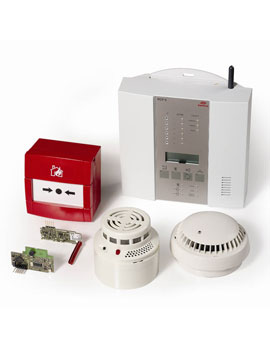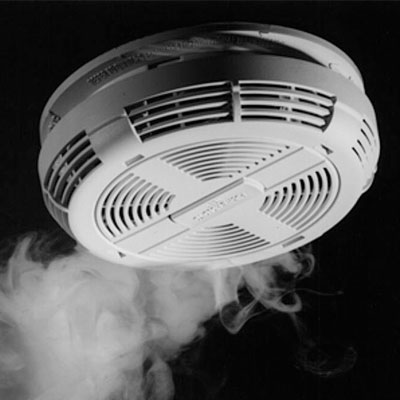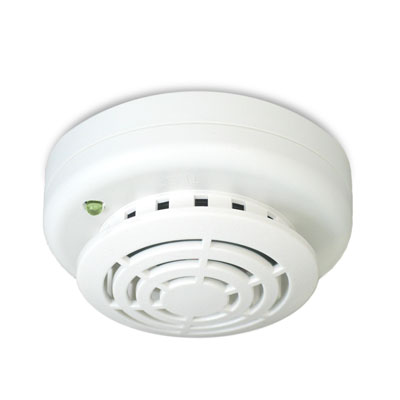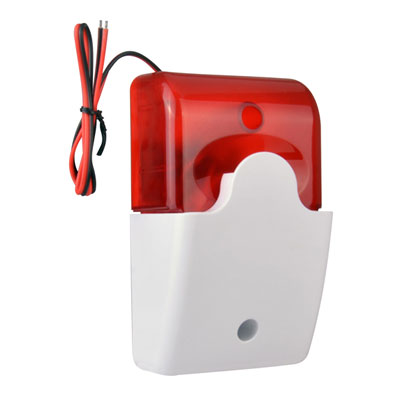 Additionally, paste this code immediately after the opening tag:
Additionally, paste this code immediately after the opening tag:

A fire alarm system is number of devices working together to detect and warn people through visual and audio appliances when smoke, fire, carbon monoxide or other emergencies are present. These alarms may be activated automatically from smoke detectors, and heat detectors or may also be activated via manual fire alarm activation devices such as manual call points or pull stations. Alarms can be either motorized bells or wall mountable sounders or horns. They can also be speaker strobes which sound an alarm, which warns people inside the building not to use the elevators.

A smoke detector is a device that senses smoke, typically as an indicator of fire. Commercial security devices issue a signal to a fire alarm control panel as part of a fire alarm system

A heat detector is a fire alarm device designed to respond when the convected thermal energy of a fire increases the temperature of a heat sensitive element. The thermal mass and conductivity of the element regulate the rate flow of heat into the element. All heat detectors have this thermal lag. Heat detectors have two main classifications of operation, "rate-of-rise" and "fixed temperature." The Heat detector is used to help in the reduction of damaged property. It is triggered when temperature increases.

An optical beam smoke detector is a device that uses a projected beam of light to detect smoke across large areas, typically as an indicator of fire. They are used to detect fires in buildings where standard point smoke detectors would either be uneconomical or restricted for use by the height of the building.

Manual alarm call points are designed for the purpose of raising an alarm manually once verification of a fire or emergency condition exists, by operating the push button or break glass the alarm signal can be raised

Outdoor sirens and strobe sirens are often overlooked in favor of Fire alarm systems. Yet, the very point of an alarm is to make an emergency situation known. ... Mounting an siren and strobeserves Alerts the people to know that there is a fire .

Conventional system, there is no way of pinpointing the exact location of the fire. However, by wiring your building into different zones, you can get a general idea of where the fire is. For instance, if you have two floors, you could wire the first as 'zone 1' and the second as zone 2. So if a fire occurs in zone 1, you know that the fire is somewhere on the first floor.
Conventional system alarm, each device will be connected to the control panel via its own wire, rather than a shared one. One end of the wire will be touching the device, and another touching the control panel.
Every device connected to the addressable system has its own unique address. When a fire is detected, the device's address shows up on the main control panel, telling you exactly which device has been activated. This will enable you to find the exact location of a fire and extinguish them quickly.
Addressable alarm systems connect devices using a loop. This is where one wire connects all devices to the control panel. Both ends of the wire loop connect to the control panel.
VESDA Systems are aspirating smoke detection used for early warning applications where response to a fire is critical. VESDA® works by continually drawing air into the pipe network via a high efficiency aspirator. A sample of this air is then passed through a dual stage filter.
Conventional alarm panels cost a lot less to buy but are more expensive to install. This is because each device that is being connected needs its own wire. With addressable systems, one wire loop will connect several devices. This means conventional systems require more wire and more man hours during the installation phase.
Additionally, addressable systems have a range of other facilities that can help save money. For instance, addressable alarm panels monitor the air flow through smoke detectors to prevent the occurrence of false alarms, which can be costly to a business.

The addressable alarm panel is also the more reliable of the two. This is because the wire connects to the control panel at both ends. If one end of the loop becomes severed, signals can still be sent to the control panel via the other end of the loop. Loop isolation modules are also used to separate devices on the loop. This means that if one device becomes disconnected, it won't disable the circuit. With a conventional system, if a wire has become severed, the device will become disconnected.
Functionally, the addressable fire alarm unit is superior, which can help prevent costly activities and save time when detecting a fire. It's also cheaper and easier to install. But in terms of buying price, a conventional system is cheaper, and will meet the functional needs of small premises where a sophisticated system is not necessary.
